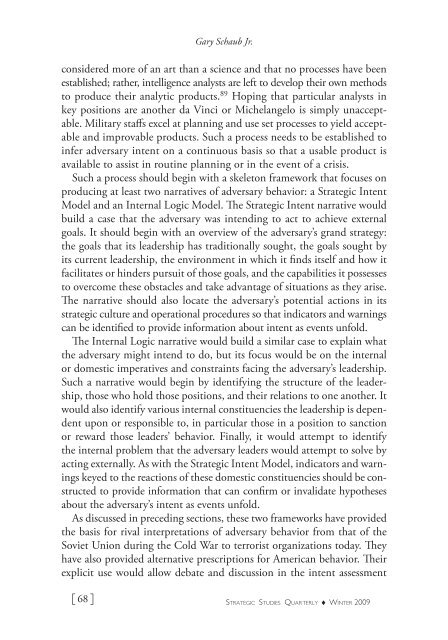When Is Deterrence Necessary? Gauging Adversary Intent
When Is Deterrence Necessary? Gauging Adversary Intent
When Is Deterrence Necessary? Gauging Adversary Intent
Create successful ePaper yourself
Turn your PDF publications into a flip-book with our unique Google optimized e-Paper software.
Gary Schaub Jr.<br />
considered more of an art than a science and that no processes have been<br />
established; rather, intelligence analysts are left to develop their own methods<br />
to produce their analytic products. 89 Hoping that particular analysts in<br />
key positions are another da Vinci or Michelangelo is simply unacceptable.<br />
Military staffs excel at planning and use set processes to yield acceptable<br />
and improvable products. Such a process needs to be established to<br />
infer adversary intent on a continuous basis so that a usable product is<br />
available to assist in routine planning or in the event of a crisis.<br />
Such a process should begin with a skeleton framework that focuses on<br />
producing at least two narratives of adversary behavior: a Strategic <strong>Intent</strong><br />
Model and an Internal Logic Model. The Strategic <strong>Intent</strong> narrative would<br />
build a case that the adversary was intending to act to achieve external<br />
goals. It should begin with an overview of the adversary’s grand strategy:<br />
the goals that its leadership has traditionally sought, the goals sought by<br />
its current leadership, the environment in which it finds itself and how it<br />
facilitates or hinders pursuit of those goals, and the capabilities it possesses<br />
to overcome these obstacles and take advantage of situations as they arise.<br />
The narrative should also locate the adversary’s potential actions in its<br />
strategic culture and operational procedures so that indicators and warnings<br />
can be identified to provide information about intent as events unfold.<br />
The Internal Logic narrative would build a similar case to explain what<br />
the adversary might intend to do, but its focus would be on the internal<br />
or domestic imperatives and constraints facing the adversary’s leadership.<br />
Such a narrative would begin by identifying the structure of the leadership,<br />
those who hold those positions, and their relations to one another. It<br />
would also identify various internal constituencies the leadership is dependent<br />
upon or responsible to, in particular those in a position to sanction<br />
or reward those leaders’ behavior. Finally, it would attempt to identify<br />
the internal problem that the adversary leaders would attempt to solve by<br />
acting externally. As with the Strategic <strong>Intent</strong> Model, indicators and warnings<br />
keyed to the reactions of these domestic constituencies should be constructed<br />
to provide information that can confirm or invalidate hypotheses<br />
about the adversary’s intent as events unfold.<br />
As discussed in preceding sections, these two frameworks have provided<br />
the basis for rival interpretations of adversary behavior from that of the<br />
Soviet Union during the Cold War to terrorist organizations today. They<br />
have also provided alternative prescriptions for American behavior. Their<br />
explicit use would allow debate and discussion in the intent assessment<br />
[ 68 ]<br />
Strategic Studies Quarterly ♦ Winter 2009
















